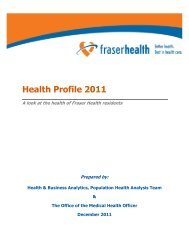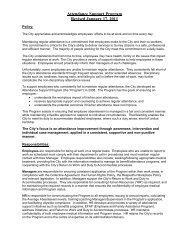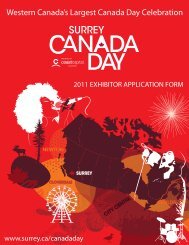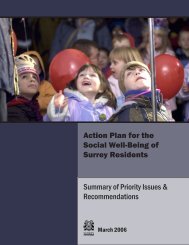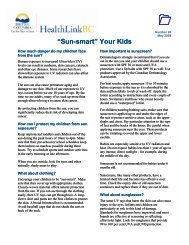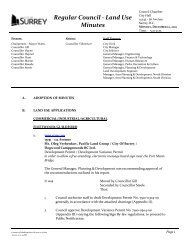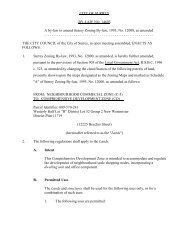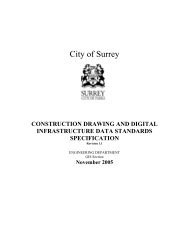Blackie Spit Park: Wildlife Habitat Enhancement Plan - City of Surrey
Blackie Spit Park: Wildlife Habitat Enhancement Plan - City of Surrey
Blackie Spit Park: Wildlife Habitat Enhancement Plan - City of Surrey
Create successful ePaper yourself
Turn your PDF publications into a flip-book with our unique Google optimized e-Paper software.
passerines, and to a much lesser extent, waterfowl. It sought to address opportunities to replace<br />
several Sea Island habitat types that were lost: agricultural fields (hay fields and old-fields);<br />
hedgerows; mixed, scrubby woodlots; ditches; and to a small extent, wetlands and seasonally flooded<br />
fields.<br />
Some <strong>of</strong> the management recommendations from that plan are still valid, but the scope <strong>of</strong> the present<br />
plan encompasses a much broader range <strong>of</strong> wildlife management interests and its habitat management<br />
units and management prescriptions are much more detailed.<br />
1.3 Acknowledgements<br />
Several people have provided helpful comments and ideas that contributed to this report. In<br />
particular, I would like to acknowledge the input <strong>of</strong> the steering committee members, who included<br />
Greg Ward, Wayne Sakmoto, Shawn Gurney, and Martha Norman <strong>of</strong> <strong>Surrey</strong> <strong>Park</strong>s, Recreation &<br />
Culture, and Rene Savenye, Eilene Verheuil, and Margaret Cuthbert <strong>of</strong> the White Rock and <strong>Surrey</strong><br />
Naturalists. Shawn Gruney was also very helpful in providing the <strong>Blackie</strong> <strong>Spit</strong> map information in<br />
electronic format.<br />
2.0 <strong>Blackie</strong> <strong>Spit</strong> <strong>Habitat</strong>s in Context<br />
2.1 Global<br />
<strong>Blackie</strong> <strong>Spit</strong> is located within the Fraser Delta (Figure 1), the largest estuary on the Pacific coast <strong>of</strong><br />
Canada and supports the highest densities <strong>of</strong> waterbirds, shorebirds, and raptors in Canada in winter.<br />
It also forms a link in a series <strong>of</strong> estuaries used by migrating birds, from the Copper River delta in<br />
Alaska to the estuaries and wetlands <strong>of</strong> the west coast <strong>of</strong> Washington, Oregon, and California in the<br />
U.S. (Butler and Campbell 1987).<br />
Besides waterfowl, unnumbered passerine birds migrate along the coast and through the delta<br />
between their arctic breeding grounds and tropical and subtropical wintering areas. Often, points <strong>of</strong><br />
land such as <strong>Blackie</strong> <strong>Spit</strong> attract such birds, and become places to which people flock hoping to catch<br />
a glimpse <strong>of</strong> species that occur only on migration and rarities that frequently show up in such<br />
locations.<br />
2.2 Regional<br />
In some years, as many as 1.4 million birds (waterfowl, shorebirds, and gulls) migrate through the<br />
Fraser River delta. In winter, about 135,000 waterbirds use the delta due to its mild winter climate,<br />
extensive marshes and mud flats, and abundance <strong>of</strong> food associated with intertidal and agricultural<br />
habitats (Butler and Campbell 1987).<br />
<strong>Blackie</strong> <strong>Spit</strong> <strong>Park</strong>: <strong>Wildlife</strong> <strong>Habitat</strong> <strong>Enhancement</strong> <strong>Plan</strong> – PART 1: Background and Summary 2



